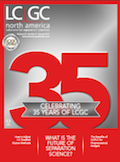Separations: A Way Forward
Special Issues
A.M. Stalcup

The analytical separations community has really made tremendous advances in the last couple of decades to satisfy the demands for higher throughput and address the increasing demands presented by the complexities of various “omics” samples (proteomics, glycomics, metabolomics, and so forth). These advances have been largely accomplished through a collective re-envisioning of separation platforms (for example, solid-phase microextraction, microfluidics, and capillary electrophoresis), mobile phases (such as supercritical fluids and enhanced fluidity), chromatographic media (for example, chiral, smaller particles, core-shell particles, monoliths, and polymerized ionic liquids), and practice (such as slip flow, ultrahigh pressures in high performance liquid chromatography [HPLC], and ultrahigh-temperature gas chromatography [GC] and HPLC). As a result, a very sophisticated material science has emerged and it is astounding that the range of analytes that can now be resolved by the separations community extends from ions to small molecules to polymers, biopolymers, cell organelles, and even cells.
The paradox is that one of the biggest challenges facing separation science is that many of our academic colleagues consider what separations scientists do as merely a necessary evil in support of “real” science and either witchcraft or trivial, while our industrial colleagues decry the declining chromatographic expertise in some of our graduates. Some of this generally low esteem (it is now more than 65 years since Martin and Synge’s Nobel prize and one cannot help but feel occasionally that some scientists would be just as happy if separations were retired) for separation science by our academic colleagues is perhaps historical as Twsett’s original work was ignored or ridiculed by his contemporaries. These attitudes may also have given rise to historically low funding for fundamental separations science research. Nevertheless, this “familiarity breeds contempt” quality arguably impacts analytical chemistry in other areas as well (for example, perhaps spectroscopy and electrochemistry). Hence, the analytical separations community might be advised to adopt strategies used by more highly regarded analytical techniques such as mass spectrometry (MS) to boost stature.
While MS is one of the oldest analytical techniques (that is, 1913: isotopes of neon), the last couple of decades have seen an incredible evolution in instrumentation and methodologies to tackle emerging analytical problems previously beyond the scope of contemporaneously available instrumentation. This was in part enabled by the coherence of the MS community in coupling advances in computer science, data management, and electronics to new interfaces and discriminatory power. However, it might also be argued that another contributory factor is that the MS community never forgot they were chemists first. This is clear from the early groundbreaking work by McLafferty relating electron impact ionization fragmentation to chemical structure (1) right through more recent work looking at hydrogen-deuterium exchange mass spectrometry and reexamination of the role of the matrix-assisted laser desorption-ionization (MALDI) matrix in ionization (2).
After a couple decades of engineering faster, better separations, it may be time for the separation science community to remember their chemical roots and bring a little supra-analytical separation science (SaSS) to the table, exploiting the dynamic chemical interactions between solute, mobile phase, and stationary phase that mask a wealth of inherent molecular information about interactions. The increasing success of chemically informed predictive retention models (for example, linear solvation energy relationships) are now approaching levels where separation science can provide a powerful enabling technology for predictions of performance and conditions to address emerging challenges (for example, pharmaceutical formulations) that were never previously considered amenable to separations-based approaches.
Finally, I want to heartily congratulate the LCGC team for LCGC North America’s 35th year of publishing! I originally encountered LCGC as a graduate student at Georgetown University. As a novice just finding my professional legs, I appreciated the accessibility of the scientific articles and the announcements of conferences, awards, and so on. Often, the first articles I read were the regular troubleshooting columns by John Dolan and John Hinshaw because the practical advice provided was particularly valuable in sorting out the mysteries of filters, ferrules, and connections, especially in academic labs where the relevant technical expertise was often in short supply. At the time, LCGC was one of the few places to find that kind of help and the spirit of open sharing of hard-earned information and a sense of a common purpose (that is, better, faster, separations) helped shape my enduring professional outlook! Over the course of my academic career, I have encouraged students to take advantage of the free subscription and used some of the material in my classes. Fortunately, I was able to leave my extensive collection of back issues when I moved to Ireland (LCGC’s reach is truly global) now that the articles are readily accessible on-line. Well done and thank you!
References
- F.W. McLafferty, Anal. Chem. 31, 82–87 (1959).
- J.R. Engen, Anal. Chem.81, 7870–7875 (2009).
A.M. Stalcup is with the School of Chemical Sciences at Dublin City University in Dublin, Ireland.

Determining the Link Between Prenatal Cannabis Use and Symptoms of Depression Using LC–MS/MS
April 16th 2025Researchers investigating the relationship between cannabis use during pregnancy and depressive symptoms—and whether continued use beyond the first trimester or higher levels of use were linked to increased symptoms—used liquid chromatography–tandem mass spectrometry (LC–MS/MS) to confirm the presence of 11-nor-9-carboxy-delta-9-tetrahydrocannabinol (THC-COOH) in urine samples.
A Guide to (U)HPLC Column Selection for Protein Analysis
April 16th 2025Analytical scientists are faced with the task of finding the right column from an almost unmanageable range of products. This paper focuses on columns that enable protein analysis under native conditions through size exclusion, hydrophobic interaction, and ion exchange chromatography. It will highlight the different column characteristics—pore size, particle size, base matrices, column dimensions, ligands—and which questions will help decide which columns to use.
Common Challenges in Nitrosamine Analysis: An LCGC International Peer Exchange
April 15th 2025A recent roundtable discussion featuring Aloka Srinivasan of Raaha, Mayank Bhanti of the United States Pharmacopeia (USP), and Amber Burch of Purisys discussed the challenges surrounding nitrosamine analysis in pharmaceuticals.




















